발목 염좌(발목 삠)와 탈구 Ankle sprains and ankle dislocation
발목 염좌의 정의
-
어떤 관절이 갑자기 비틀려 관절을 형성하고 있는 인대(Ligaments)의 일부나 전부가 째진 상처를 염좌, 또는 삔다고 한다.
-
발목이 갑자기 비틀려 거기에 있는 인대가 째진 상처를 발목 염좌, 또는 발목 삠이라 한다.
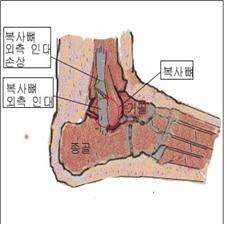
그림 71. 발목 측면과 외측발목 인대 손상
Copyright ⓒ 2011 John Sangwon Lee, M.D., FAAP
발목 염좌의 원인
-
관절이 정상적으로 움직일 수 있는 범위 이상으로 움직여 그 관절에 붙어있는 건이나 인대(靭帶)의 일부, 또는 전부가 째진 상처를 염좌라고 한다.
-
그런 상태가 생겼을 때 비의료인들은 “삐었다“라고 흔히 말한다.
-
발목에 생긴 염좌를 발목 염좌, 발목 삠이라하고 “발목이 삐었다“라고 말다.
-
장난이나 달리기 운동 등 육체적 운동을 하다가, 또는 안전사고로 발목, 무릎, 팔꿈치, 어깨, 손가락 등의 관절이 삘 수 있다.
-
특히 울퉁불퉁한 길바닥에서 달일 때 더 잘 생기고 발이 내번 될 때 발목 관절의 외측 인대 손상이 가장 잘 생길 수 있다.
-
신체에 있는 거의 모든 관절이 삘 수 있지만 특히 발목 관절은 신체의 전 체중을 지탱하는 기능을 하고 많이 쓰는 관절이기 때문에 더 자주 삘 수 있다.
-
어깨 관절도 상대적으로 많이 쓰는 관절이기 때문에 신체 다른 관절에 비해서 보다 더 쉽게 삘 수 있고 자주 삘 수 있다.
-
여자농구 선수들에게 가장 흔히 생기는 염좌는 발목 염좌이다.
-
과거에 한번이라도 염좌가 생겼던 병력이 있으면 염좌 재발생률이 높다.
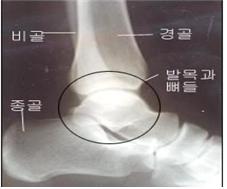
사진76. 발목관절 X-사진
발목 관절은 경골, 비골, 거골, 종골, 인대, 활막 등으로 이루어졌다. ◯내 발목 관절
Copyright ⓒ 2011 John Sangwon Lee, M.D., FAAP
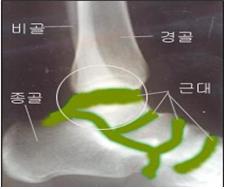
사진77. 발목관절 X-사진(◯)과 발목 관절과 족근골 사이에 있는 인대(녹색으로 표시된 부분)
Copyright ⓒ 2011 John Sangwon Lee, M.D., FAAP
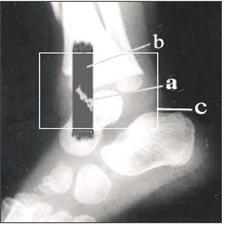
사진 74. 삔 발목
a-손상된 발목 인대, b-발목 건, c-발목 관절(□)
Copyright ⓒ 2011 John Sangwon Lee, M.D., FAAP

사진 75. 발목 관절이 비틀릴 때 그로 인해 아킬레스 건(b)이 손상될 수 있다.
Copyright ⓒ 2011 John Sangwon Lee, M.D., FAAP
발목 염좌(발목삠)의 증상 징후
-
발목 관절이 삐었을 때 생길 수 있는 증상 징후는 발목 관절 속에 있는 비골, 경골, 족근골 등 뼈가 골절될 때나, 발목 관절 속에 있는 비골 두부, 경골 두부(骨頭)가 탈구될 때 생길 수 있는 증상 징후와 거의 비슷할 수 있다.
발목 염좌(발목 삠)의 급수
-
발목관절을 이루고 있는 여러 종류의 인대들 중 어떤 인대가 얼마나 손상 입었나에 따라, 발목 염좌의 증상 징후 등에 따라 발목 염좌를
1. 1급 발목 염좌
2. 2급 발목 염좌
3. 3급 발목 염좌 등 3급 발목 염좌로 나눈다.
-
발목 염좌의 급수에 따라 증상 징후가 다르다.
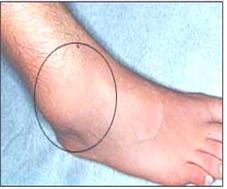
사진 73. ◯으로 표시된 오른쪽 발목 부분이 삐어 발목이 많이 부었다.
Copyright ⓒ 2011 John Sangwon Lee, M.D., FAAP
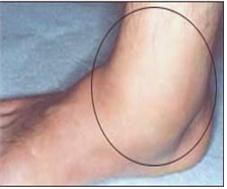
사진 72. ◯으로 표시된 부위에 삔 왼쪽 발목
그냥 보고 만지고 검진해서 그 관절에 있는 뼈가 골절되어 있는지 건이 째져 삐기만 했는지 골절과 염좌가 동시 생겼는지 확실히 알 수 없는 때가 많다.
Copyright ⓒ 2011 John Sangwon Lee, M.D., FAAP
-
관절이 삐면 삔 관절이 아프고,
-
째진 인대부분을 만지면 아프고 붓고,
-
정상적으로 잘 움직일 수 없다.
-
특히 발목이 삔 후 즉시 아플 수 있고, 그 후 얼마간 상당히 아플 수 있다.
-
때로는 삔 후 처음 한두 시간 동안은 많이 붓지도 않고 심하게 아프지 않을 수 있다. 그렇지만 그 후 시간이 점점 더 지나가면서 삔 관절이 점점 더 붓고 은근히 더 아플 수 있다.
-
삔 지 1~2일 정도 지나면 삔 관절 부분의 피부가 멍들 수 있고, 그 관절에 통증이 은근히 생기고 아파서 그 관절을 움직이기도 힘들 수 있다.
표 22. 발목 염좌 급수 분류 Classification of ankle sprains
| 발목 염좌의 정도 | 앞 발목 종아리 인대(전거 인대) 이완 정도 | 반상 출혈 | 부종 | 발목을 정상으로 움직여 쓸 수 있는 기간 |
| 1급 발목 염좌 | 없다 | 없다 | 약간 있다 | 2~1일 |
| 2급 발목 염좌 | 경도 | 조금 있을 수 있다 | 경도로 있다 | 2~4주 |
| 3급 발목 염좌 | 상당이 생긴다 | 확실히 있다 | 많이 생긴다 | 4~6주 |
출처; Sports Med Connecticut State Medical Society, Winter, 2008 p.8
발목 염좌(발목 삠)의 진단
-
병력, 증상 징후와 진찰소견 등을 종합해서 발목 관절이 삐었다고 의심되면 삔 관절 X선 사진 검사 등으로 진단할 수 있다.
-
때로는 골절, 탈구, 염좌 등 발목 관절에 생긴 상처는 X선 사진 검사를 하지 않고 그냥 진찰해서 확실히 감별 진단하기가 쉽지 않다.
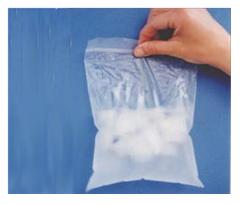
사진 78. 지퍼 백 얼음물 주머니를 수건으로 적절히 싸서 온도를 적절히 조절하면서 찬 찜질을 할 수 있다.
Copyright ⓒ 2011 John Sangwon Lee, M.D., FAAP
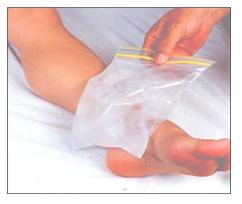
사진 79. 삔 발목 관절을 얼음물 주머니로 찬찜질하면 덜 아프고 덜 부을 수 있다.
Copyright ⓒ 2011 John Sangwon Lee, M.D., FAAP
발목 염좌(발목 삠)의 치료
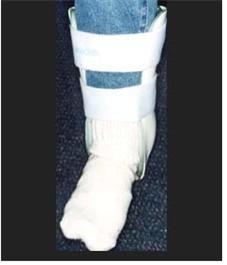
사진 90. 삔 발목과 그 부위에 부목을 대어
응급치료 할 수 있다.
Copyright ⓒ 2011 John Sangwon Lee, M.D., FAAP
-
발목 관절의 여러 인대나 중 어떤 인대가 손상되어 발목 염좌가 어느 정도로 생겼는지, 또 어떤 합병증이 생겨 있는지, 나이에 따라 치료가 다를 수 있다.
-
교통사고나 안전사고 등으로 발목 관절이 삐었을 경우엔 신체 다른 부위에도 찰과상, 절상 또는 자상 등 외상을 동시 입었을 수 있다.
-
교통사고로 어떤 관절이 삐었을 때 삔 관절을 적절히 응급 치료를 해 주는 것도 중요하지만 호흡곤란이 있는지, 염좌 이외 뼈가 골절이 되어있는지 탈구 등 다른 외상이 있는지 알아보고, 있으면 그것도 동시 적절히 응급 치료한다.
-
호흡곤란이 있으면 기도 확보를 하는 처치를 우선 하여 숨 쉴 수 있게 하는 처치를 해야 한다.
-
아파하면 환아를 진정시킨다.
-
상황에 따라 의료구급대, 병원 응급실, 또는 단골 소아청소년과 의사에게 긴급 전화 진료 상담을 해서 그들의 지시에 따라 구급차나 적절한 다른 교통수단으로 환아를 적절한 병원으로 이송한다.
-
교통사고나 안전사고 등으로 발목 염좌가 생기고 크게 다쳤을 때는 의사나 의료구급대원이나 구급차가 현장에 도착할 때까지 그 상황에서 응급처치에 관한 의사의 지시가 없을 때는 가능한 한 처음 발견됐을 때 환아가 취했던 자세와 거의 같은 자세 그대로 계속 취하게 하고 환자를 현장에서 다른 장소로 함부로 옮기지 말아야 한다.
-
특히 도와주는 사람이 삔 관절을 함부로 이리 저리 움직이지 말아야 한다.
-
다리에 있는 관절이 조금 삐었을 때는 삔 관절을 몸통보다 조금 더 높게 받쳐 올려놓으면 덜 아플 수 있고 덜 부을 수 있다.
-
발목 X선 검사 등을 해도 확실히 발목 어느 부분에 손상이 생겼는지 모르는 때가 많다. 그냥 보고서 어디가 손상됐다고 진단할 수 없다.
-
상황에 따라 베개나 둘둘 만 담요, 또는 판자 등으로 삔 발목 관절 부위와 그 관절의 위아래에 있는 성한 신체 부위에 부목을 대고 병원 응급실이나 의사에게 데리고 갈 수 있다.
-
이때도 될 수 있으면 삔 발목 관절을 함부로 움직여서는 안 된다.
-
될 수 있으면 발목 관절이 삔 후 처음 목격한 자세 그대로 유지하고 삔 부위에 부목을 적절히 댈 수 있다.
-
삔 발목 관절이 붓고 아플 때는 삔 관절에 얼음물 주머니 찬찜질을 해 줄 수 있다.
-
1급 발목 염좌가 있는 발목, 단순히 삔 발목 관절을 약 7∼14일 동안 쓰지 않고 쉬면 잘 낫는다.
-
발목 관절이 다쳤을 때 관절이 삐기만 했는지, 탈구만 되었는지, 관절 속 뼈의 일부가 골절되었는지, 염좌와 골절이 함께 있는지 의사도 누구도 겉으로 그냥 보고서 확실히 감별 진단할 수가 없다.
-
따라서 발목 관절이 삐었다고 의심될 때는 관절 X-선 사진 검사 등을 받고 의사의 진단 치료를 받는 것이 이상적이다.
-
발목 관절뼈가 골절됐거나 탈구되지 않고 조금 삐었을 때는 의사의 지시에 따라 삔 발목 관절과 그 부위를 탄력붕대 등으로 감아주고 1∼2주 동안 그 발목 관절을 쓰지 않고 관찰하면서 치료할 수 있다.
-
또 발목 관절이 좀 심하게 삐었을 때 삔 발목 관절을 탄력붕대로 감아주거나 부목을 대고(사진90. 참조) 그 관절을 쓰지 않고 쉬면서 치료를 해 줄 수 있다([부모도 반의사가 되어야 한다–소아가정간호백과]-제21권 소아청소년 가정간호–탄력붕대 참조).
-
발목이 삐었을 때 삔 발목 관절이 많이 아프고 부으면 다 나을 때까지 그 발목 관절을 절대로 쓰지 말아야 한다.
-
부득이 걸어야 할 때는 목발을 이용해 걸을 수 있지만 그 발에는 체중과 힘을 가해서는 안 된다.
-
발목 관절이 심하게 삔 경우, 수술 치료를 받기도 한다.
-
대부분의 염좌는 2∼3주일 정도 지나면 완치된다.
-
이런 복잡한 염좌 치료는 어디까지나 정형외과 전문의에게 의뢰해 치료받는 것이 이상적 치료이다.
-
1~2급 발목 삠은 보호, 레스트(안정을 취함), 얼음찜질, 압박 붕대 치료, 거상 등으로 치료하는 것이 보통이다.
Ankle sprains and ankle dislocation 발목 염좌(발목 삠)와 탈구
What is an ankle sprain?
• A sprain or sprain is an injury in which some or all of the ligaments forming the joint are suddenly twisted and torn.
• Ankle sprains, or ankle sprains, are injuries where the ankle is suddenly twisted and the ligaments there are torn.

Figure 71. Ankle lateral and lateral ankle ligament injuries Copyright ⓒ 2011 John Sangwon Lee, M.D., FAAP
Causes of Ankle Sprains
• A joint that moves beyond the normal range of motion and cuts off part or all of the tendons or ligaments attached to the joint is called a sprain.
• When such a condition occurs, non-medical practitioners often refer to it as “sprained.”
• A sprain in the ankle is called an ankle sprain or sprained ankle, and they say, “I sprained my ankle.”
• Sprained joints such as ankles, knees, elbows, shoulders, and fingers can occur during physical exercise such as playing games or running, or as a result of a safety accident.
• In particular, it is more likely to occur when scalding on a bumpy road, and damage to the lateral ligament of the ankle joint is most likely to occur when the foot is inverted.
• Almost any joint in the body can be sprained, but the ankle joint in particular can be sprained more frequently because it supports the entire body weight and is a commonly used joint. • Since the shoulder joint is also a relatively used joint, it can be sprained more easily and frequently than other joints in the body.
• The most common sprain in women’s basketball players is an ankle sprain.
• If you have had at least one sprain in the past, the recurrence rate is high.

Picture 76. ankle joint x-photograph The ankle joint was composed of the tibia, fibula, talus, calcaneus, ligaments, and synovial membrane. ◯My ankle joint Copyright ⓒ 2011 John Sangwon Lee, M.D., FAAP

Picture 77. Ankle X-photograph (◯) and the ligament between the ankle joint and the tarsal bone (shown in green) Copyright ⓒ 2011 John Sangwon Lee, M.D., FAAP

Photo 74. Sprained ankle a-injured ankle ligament, b-ankle tendon, c-ankle joint (□) Copyright ⓒ 2011 John Sangwon Lee, M.D., FAAP

Picture 75. When the ankle joint is twisted, it can damage the Achilles tendon (b). Copyright ⓒ 2011 John Sangwon Lee, M.D., FAAP
Signs, symptoms of an ankle sprain (ankle sprain)
• Symptoms that can occur when the ankle joint is sprained Signs of symptoms that may occur when bones such as the fibula, tibia, and tarsal bones in the ankle joint are fractured or when the fibula head or tibia head in the ankle joint is dislocated can be almost similar to A series of ankle sprains (ankle sprains)
• Ankle sprains can be treated according to the extent of damage to which of the various types of ligaments that make up the ankle joint and the symptoms of ankle sprains.
1. Grade 1 ankle sprain
2. Grade 2 ankle sprain
3. Class 3 ankle sprains, such as grade 3 ankle sprains.
• Symptoms vary depending on the severity of ankle sprain.

Picture 73. The part of the right ankle marked with ◯ was sprained and the ankle was swollen. Copyright ⓒ 2011 John Sangwon Lee, M.D., FAAP

Picture 72. Left ankle sprained in the area marked with
◯ There are many times when it is not possible to know for sure whether the bone in the joint is fractured, just a sprained tendon, or a fracture and sprain occurred at the same time by simply looking, touching, and examining. Copyright ⓒ 2011 John Sangwon Lee, M.D., FAAP
• When a joint is sprained, the sprained joint hurts,
• It hurts and swells when you touch the torn ligament;
• I can’t move well normally.
• You may feel pain immediately after a sprain, especially your ankle, and may be quite sore for some time thereafter.
• Sometimes during the first hour or two after a sprain, it may not swell as much or be very painful. However, as time passes, the sprained joint may become increasingly swollen and subtly painful.
• After 1 to 2 days after the sprain, the skin at the sprained joint may be bruised, and the joint may be in pain and it may be difficult to move the joint.
Table 22. Classification of ankle sprains 표 22. 발목 염좌 급수 분류
| degree of ankle sprain | Degree of relaxation of the anterior ankle calf ligament (anterior anteroposterior ligament) | ecchymosis | edema | How long you can use your ankle with normal movement |
| Grade 1 ankle sprain | none | none | somewhat | 2~1 day |
| Grade 2 ankle sprain | mild | there may be a little | mild | 2~4 weeks |
| Grade 3 ankle sprain | there is a lot | definitely is | there is a lot | 4~6 weeks |
source; Sports Med Connecticut State Medical Society, Winter, 2008 p.8
Diagnosis of an ankle sprain (ankle sprain)
• If it is suspected that the ankle joint is sprained by combining the medical history, symptom signs, and examination findings, it can be diagnosed with a sprained joint X-ray examination.
• Sometimes, it is difficult to make a definitive differential diagnosis of wounds in the ankle joint, such as fractures, dislocations, and sprains, by simply examining them without X-ray examination.

Photo 78. Zipper bag The ice water bag can be properly wrapped in a towel to provide a cold compress while controlling the temperature appropriately. Copyright ⓒ 2011 John Sangwon Lee, M.D., FAAP

Photo 79. Cold compresses on the sprained ankle joint with a bag of ice water can cause less pain and less swelling. Copyright ⓒ 2011 John Sangwon Lee, M.D., FAAP
Treatment of an ankle sprain (ankle sprain)

Photo 90. Splinting the sprained ankle and the area emergency treatment can be provided. Copyright ⓒ 2011 John Sangwon Lee, M.D., FAAP
• Treatment may vary depending on the age and the extent of the ankle sprain due to damage to several ligaments or any of the ligaments of the ankle joint, and what complications have arisen.
• If the ankle joint is sprained due to a traffic accident or safety accident, other parts of the body may be injured at the same time, such as abrasions, cuts, or cuts.
• When a joint is sprained in a traffic accident, it is important to provide appropriate emergency treatment for the sprained joint, but if there is difficulty in breathing, other than sprains, bone fractures, dislocations, etc..
• If you have difficulty breathing, you should give priority to treatment to secure the airway, and treatment to allow breathing.
• If it hurts, calm the child down.
• Depending on the situation, make an emergency telephone consultation with a medical emergency department, hospital emergency room, or regular pediatrician, and transfer the patient to an appropriate hospital by ambulance or other suitable means of transportation according to their instructions.
• In the case of an ankle sprain or serious injury due to a traffic accident or safety accident, until a doctor, medical paramedic or ambulance arrives at the scene, if there is no doctor’s instruction regarding first aid in the situation The patient should be kept in the same posture as the posture and do not recklessly move the patient from the site to another place.
• In particular, the person helping the sprained joint should not be moved around freely.
• If the joint in the leg is slightly sprained, it can be less painful and less swollen by supporting the sprained joint a little higher than the body.
• In many cases, it is not clear which part of the ankle is damaged even after an ankle X-ray examination. You can’t just report where the damage is.
• Depending on the situation, you may be given a splint on the ankle joint splinted with a pillow, a blanket, or a plank, and other parts of the body that are above and below the joint and taken to the hospital emergency room or doctor.
• Even at this time, if possible, the sprained ankle joint should not be moved carelessly. • If possible, keep the ankle joint in the position you first witnessed after the sprain and apply a splint to the sprained area.
• When the sprained ankle joint is swollen and painful, you can apply a cold pack of ice water to the sprained joint.
• Ankle with a grade 1 ankle sprain, or simply sprained ankle joint, heals well if you do not use it for about 7-14 days.
• When the ankle joint is injured, no doctor can make a definitive diagnosis by just looking at the appearance of the joint, whether it is just a sprain, a dislocation, a partial fracture of a bone in the joint, or a sprain and a fracture.
• Therefore, when it is suspected that the ankle joint is sprained, it is ideal to undergo a joint X-ray examination and receive diagnostic treatment from a doctor.
• If the ankle joint is slightly sprained without a fracture or dislocation, the sprained ankle joint and the area can be wrapped with an elastic bandage, etc. according to the doctor’s instructions, and treated while observing the ankle joint without using it for 1 to 2 weeks.
• Also, when the ankle joint is severely sprained, the splint can be wrapped around the sprained ankle joint with an elastic bandage or a splint (see photo 90.) and the joint can be treated while resting www.drleepediatrics.com-Volume 21, Home Nursing for Children and Adolescents-See Elastic Bandage).
• When you sprain your ankle, the sprained ankle joint hurts a lot and if it swells up, you should never use the ankle joint until it is healed.
• When walking is unavoidable, you can use crutches, but do not put weight or force on your feet. • If the ankle joint is severely sprained, surgical treatment may be required.
• Most sprains are completely cured in 2-3 weeks.
• The ideal treatment for such complex sprains is to refer them to an orthopedic surgeon.
• Grade 1 or 2 ankle sprains are usually treated with protection, rest (resting them), ice packs, compression bandages, and elevation.
출처 및 참조 문헌 Sources and references
- NelsonTextbook of Pediatrics 22ND Ed
- The Harriet Lane Handbook 22ND Ed
- Growth and development of the children
- Red Book 32nd Ed 2021-2024
- Neonatal Resuscitation, American Academy Pediatrics
- www.drleepediatrics.com 제16권 소아청소년 정형외과 질환
- www.drleepediatrics.com제8권 소아청소년 호흡기 질환
- www.drleepediatrics.com제9권 소아청소년 소화기 질환
- www.drleepediatrics.com제10권. 소아청소년 신장 비뇨 생식기 질환
- www.drleepediatrics.com제11권. 소아청소년 심장 혈관계 질환
- www.drleepediatrics.com제12권. 소아청소년 신경 정신 질환, 행동 수면 문제
- www.drleepediatrics.com제13권. 소아청소년 혈액, 림프, 종양 질환
- www.drleepediatrics.com제14권. 소아청소년 내분비, 유전, 염색체, 대사, 희귀병
- www.drleepediatrics.com제15권. 소아청소년 알레르기, 자가 면역질환
- Red book 29th-31st edition 2021
- Nelson Text Book of Pediatrics 19th — 21st Edition
- The Johns Hopkins Hospital, The Harriet Lane Handbook, 22nd edition
-
Quick Reference to Pediatric Emergencies, Delmer J. Pascoe, M.D. p.164
-
Emergency Pediatrics, A guide to ambulatory care, 5th edi. Roger M. Barkin, Peter Rosen
-
Emergency care and transportation of the sick and injured, American Academy of orthopedic surgeons.
-
Nelson text book, 15 edition
-
Signs & Symptoms in Pediatrics 2nd edition
-
The Johns Hopkins Hospital, The Harriet Lane Handbook, 18th edition
-
Sports Med Connecticut State Medical Society, Winter, 2008 p.8
-
Contemporary Pediatrics, July 2008. p.46
-
Childhood Emergencies in the Office, Hospital and Community, American Academy of Pediatrics
-
Emergency Medical Service for Children, By Ross Lab. May 1989. p.10
-
Emergency care, harvey grant and robert murray
-
Emergency Care Transportation of Sick and Injured American Academy of Orthopaedic Surgeons
-
Emergency Pediatrics A Guide to Ambulatory Care, Roger M. Barkin, Peter Rosen
-
Immediate care of the acutely ill and injured, Hugh E. Stephenson, Jr
-
The Critically Ill Child, Diagnosis and Management, Edited by Clement A. Smith
-
Emergency Medical Services for Children: The Role of the Primary Care Provider, America Academy of Pediatrics
-
Quick Reference To Pediatric Emergencies , Delmer J. Pascoe, M.D., Moses Grossman, M.D. with 26 contributors
-
Manual of Emergency Care
-
응급환자관리 정담미디어
-
소아가정간호백과–부모도 반의사가 되어야 한다, 이상원
-
Neonatal Resuscitation American heart Association
-
Neonatology Jeffrey J.Pomerance, C. Joan Richardson
-
Pediatric Resuscitation Pediatric Clinics of North America, Stephen M. Schexnayder, M.D.
-
Pediatric Critical Care, Pediatric Clinics of North America, James P. Orlowski, M.D.
-
Preparation for Birth. Beverly Savage and Dianna Smith
- Infectious disease of children, Saul Krugman, Samuel L Katz, Ann A. Gerhon, Catherine Wilfert
-
The Harriet Lane Handbook 19th Edition
-
소아과학 대한교과서
-
제1권 소아청소년 응급의료 참조문헌과 출처
-
Other
Copyright ⓒ 2015 John Sangwon Lee, MD., FAAP
“부모도 반의사가 되어야 한다”-내용은 여러분들의 의사로부터 얻은 정보와 진료를 대신할 수 없습니다.
“The information contained in this publication should not be used as a substitute for the medical care and advice of your doctor. There may be variations in treatment that your doctor may recommend based on individual facts and circumstances. “Parental education is the best medicine.”